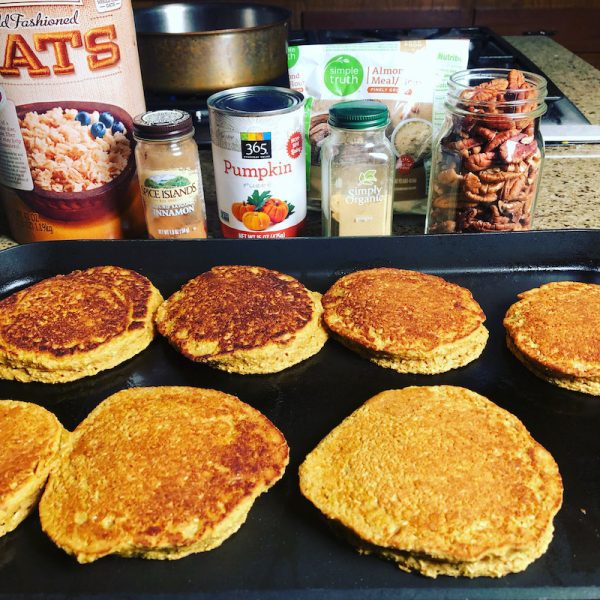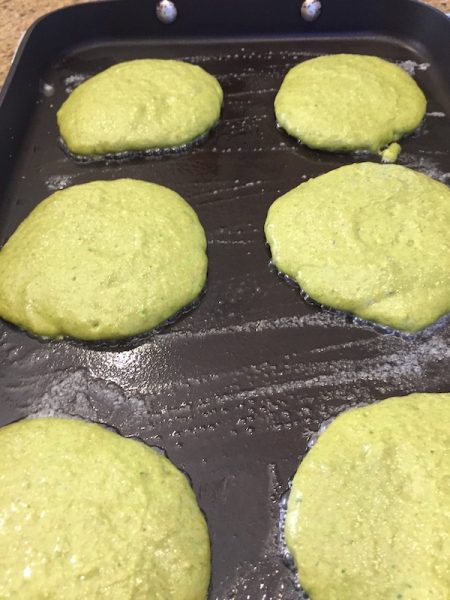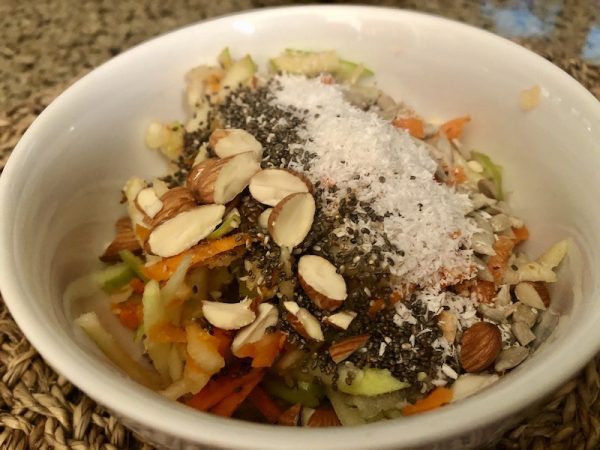I believe breakfast matters. Think:
- Macronutrient balance: Protein (eggs, sausage, whole-milk, plain Greek yogurt, hemp seed), healthy fats (coconut oil, almond butter, butter), complex carbs (oats, whole-grain flours, sweet potato, veggies)
- Micronutrient diversity: Nuts and/or seeds (pumpkin, sunflower, chia or flaxseeds), spices (such as cinnamon, cardamom, cloves, ginger, nutmeg, turmeric), seasonal fruit
[su_expanding_quote_book source_author=”Steven Pratt MD and Kathy Matthews” source_title=”SuperFoods: Fourteen Foods that Will Change Your Life” full_quote=”Nuts are nature’s nurseries. A nut or seed is basically a storage device that contains all the highly concentrated proteins, calories and nutrients that a plant embryo will need to flourish. It’s a simple If astounding fact: people who eat nuts regularly can enjoy a significant reduction in their risk of developing coronary heart disease. They’ll also reduce their risk of diabetes, cancer and a host of other chronic ailments.” short_quote=”Nuts are nature’s nurseries. A nut or seed is basically a storage device that contains all the highly concentrated proteins, calories and nutrients that”]
Sounds impossible to pack so much into breakfast and get out the door on time? Here staples for nutritious and delicious breakfast: 1) Granola, 2) Nutrient-dense pancakes or muffins 3) Overnight oats
Granola:
Store-bought granola has excessive sugar and unnecessary additives and fillers. Even organic ones are generally too high in calories (oils and sugar) and pricey. Homemade granola, an excellent combination of fiber, powerhouse nuts, spices and dried fruits (cranberry, raisin, apricot, dates), is quick and easy to make. One bowlful provides fiber, antioxidants, essential minerals and phytochemicals. Mix up combinations (spices, nuts, seeds, dried fruits) for variety. It’s a fabulous way to bring the seasons into our breakfast bowls – berries, peaches, and plums in the summer, sweet potato and pumpkin in the fall, cranberry, and gingerbread-inspired in the winter. Add protein for macronutrient balance.
- Hemp seeds
- Yogurt parfait: layer granola with whole-milk and seasonal fruit
- Put a generous scoop over chia pudding
Pancakes/Waffles or Muffins
Always make a double-batch to keep in the freezer. How to make them nutrient-dense?
- Whole-wheat and/or spelt flour. Sometimes almond flour or oat flour
- Mix in grated apple, carrot, pureed sweet potato, beets or pumpkin
- Add spices: cinnamon, cardamom, ginger, nutmeg
- Add nuts or seeds
For more check out Color My Pancakes
Overnight Oats
Overnight oats are a summer time staple. When the weather cools and fall marches in, cold overnight oats give way to deliciously warm oatmeal, nutrient-enriched with spices, nuts/seeds and fruits (seasonal or dried).
[su_expanding_quote_book source_author=”Steven Pratt MD and Kathy Matthews” source_title=”SuperFoods: Fourteen Foods that Will Change Your Life” full_quote=”Oats are low in calories, high in fiber and protein. They’re a rich source of magnesium, potassium, zinc, copper, manganese, selenium, thiamine. They contain important phytochemicals. The synergy of nutrients in oats make tham and outstanding and formidable SuperFood. In addition to their power to reduce disease and extend your health span, if you remember to eat a bowl of oats regularly, you’ll be on your way to better health.” short_quote=”Oats are low in calories, high in fiber and protein. They’re a rich source of magnesium, potassium, zinc, copper, manganese, selenium, thiamine. They contain”]
Base Recipe Overnight Oats
1/2 cup of oats
3/4 cup milk (I usually use almond)
1 – 2 tablespoons honey or maple syrup
1/4 – 1/2 teaspoon spice (cinnamon, cardamom, ginger or pinch of cloves)
Here are 5 easy, delicious options:
5 Quick and Healthy Overnight Oats
Making it Happen: Breakfast Rotation
- At the beginning of the month identify the recipes and check kitchen staples; make grocery list
- The first weekend: make make a double (or triple recipe pending family size) of granola
- Most weekends of the month I make a double batch of pancakes/waffles or muffins. When completely cool, I layer between parchment paper and place in a Ziploc bag. Remember to label and date the Ziploc, sounds obvious but it’s easy to forget.
- Then I rotate during the week, always starting first with a seasonal fruit or green smoothie
Sunday: Nutrient-rich pancakes or muffins with sausage
Monday: Granola yogurt parfait
Tuesday: Pancakes and (leftover) turkey sausage
Wednesday: Overnight oats
Thursday: Muffins and eggs (hardboiled or scrambled)
Friday: Overnight oats
Saturday: Generally eggs (omelet/frittata, casserole, breakfast tacos)
What about cereal? All processed breakfast cereals, have inadequate nutrition. Cereals are made with grains, but the nutrition and fiber comes from the outside bran layers and those are discarded when flour is refined. As
[su_expanding_quote_book alignment=”full” source_author=”Marion Nestle” source_title=”What to Eat” full_quote=”Breakfast cereals are supposed to be good for you and the relatively unprocessed ones still are, but most are now so thoroughly processed and sugared and filled with additives that they might as well be cookies. You can hardly find a cereal without added vitamins, so let’s call them vitamin-enriched, low-fat cookies. Cereal companies have a vested interest in getting you and your children to eat breakfast; they also want you to think that breakfast means
cereal. But the full nutrient value comes when the grains are whole or unprocessed. Once the outer layer of the grain has been removed, the starch calories come with fewer nutrients and have been converted to rapidly absorbed bad carbs. Processing cereal grains into flakes, circles and puffs makes the starches even less nutritious. Whole grains help protect against disease. Highly processed cereals do not.” short_quote=”Breakfast cereals are supposed to be good for you and the relatively unprocessed ones still are, but most are now so thoroughly processed and sugared and filled with additives that”]
However, if cereal is too hard of a habit to break, there are some high-fiber, whole-grain cereals. Combine with whole-fat milk/ minimally processed almond or oat milk) and fruit and it has more nutritrient than a bagel, bread or breakfast pastry (such as scones, store-bought muffins). In buying cereal look for:
- A short ingredient list
- Lots of fiber, least 20 percent of the day’s fiber goal
- 5 grams for sugar per service
- Avoid an ingredient list with zero sugars — theyc ontain artificial sweeteners like aspartame or Splenda.
[su_expanding_quote_book source_author=”Marion Nestle” source_title=”What to Eat” full_quote=”Overall most Big Four Cereals are vitamin-enriched desserts, but cleverly marketed with claims for health benefits that may have some scientific justification.” short_quote=”Overall most Big Four Cereals are vitamin-enriched desserts, but”]
Do you have favorite recipes for granola? Overnight oats? How about for pancakes and waffles?
Favorite Granola Recipes
Cranberry Maple Granola from The Gracious Pantry
Crunchy Granola from Kath Eats Real Food
Minimalist Baker: Super Chunky Coconut Granola
The Gracious Pantry: Clean Eating Pumpkin Granola
Flourless Pancakes and Waffles
Flourless Sweet Potato Waffles
Flourless Pumpkin Pancakes – I use a whole egg and whole-fat milk
Pancakes and Waffles
Apple Cinnamon Oatmeal Pancakes
Berries and Nut Pancakes
Weelicious: Red Beet Pancakes
Favorite Muffins
Carrot Apple Muffins
Weelicious: Very Berry Muffins
Epicurious: Pumpkin Apple Muffins
Sweet Potato Zucchini Bread – either baked in a loaf pan or muffin tins
Weelicious: Sweet Potato Muffins
For More Empowerment
Food Bites for Busy Mornings
Epicurious: How to Make Granola with a Recipe
Mind Body Green: Why You Should Be Eating More Overnight Oats
Updated from original September 2017 post










